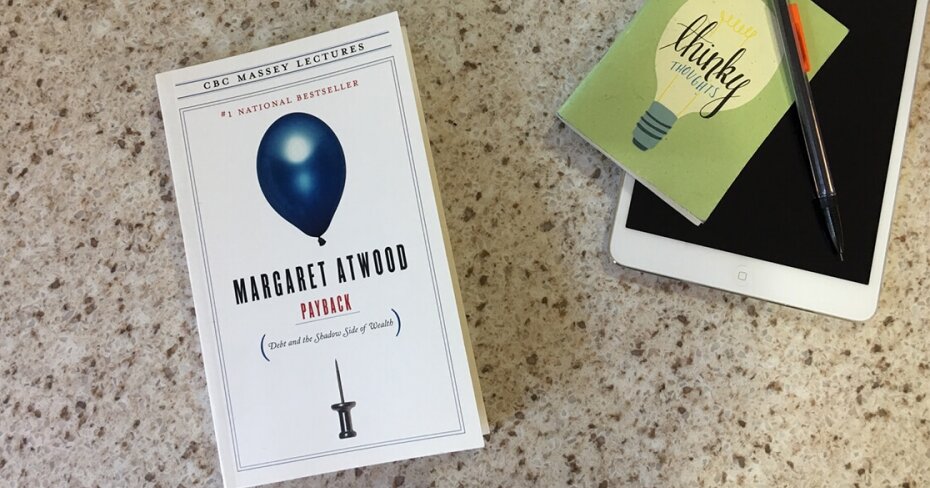LowestRates Reads: Payback: Debt and the Shadow Side of Wealth by Margaret Atwood
By: Rebecca Lee on November 30, 2016
Unlike the books we previously reviewed, Margaret Atwood’s Payback: Debt and the Shadow Side of Wealth is not a personal finance how-to. Not even close. Instead, it’s an exploration of the concept of debt and its place in our world.
And since we love to soak up “financial” commentary (that’s a loose label here) and Margaret Atwood is a literary queen, Payback is the perfect read for this week’s book review.
Book: Payback: Debt and the Shadow Side of Wealth
Year published: 2008
Author name & bio: Margaret Atwood is a world-renowned Canadian writer who’s published over 40 books of poetry, short stories, non-fiction, graphic novels, and more, many of which have received critical acclaim and prestigious awards. In 2008, she delivered Payback in a five-part CBC Massey Lectures series across Canada — timely given the financial crisis at the time — and then she published the lectures as a book. She currently lives in Toronto with fellow writer and bird aficionado, Graeme Gibson.
What’s this book all about?
Let’s start with what it’s not about. Payback is 100% not a guide to budgeting, saving, getting rich, or reaching any of our own single-minded money goals. Payback is a much broader discussion. It’s a historical, moral, religious, mythological, anthropological, and literary exploration of debt as a human construct or idea. And that’s just naming a few of the points-of-view Atwood takes as she deconstructs debt and the way it’s rooted in human culture.
Who should read this book?
Anyone who enjoys a good origin story about debt and wealth or anyone who’s curious about human behaviour and culture. Also, anyone who’s an Atwood fan. I realize that’s a very specific category of readers, but this really isn’t the type of book you seek out without any context.
3 biggest takeaways
Debt is something we made up and now we’re stuck with it
Good job, us. Like I mentioned earlier, Payback is (among other things) about the history of debt and Margaret Atwood’s very first point is that “debt exists because we imagine it.” In other words, debt isn’t a tangible thing, it’s a concept that we created. How we let debt impact our real world is something Atwood discusses in detail, but one of her more important observations is that we’ve let debt (a concept!) run our lives.
A little depressing, right? Sorry about that. But Atwood’s theory is an interesting reflection on human culture. Also, now we all wish we could turn back time and stop our ancestors from spreading the idea of debt all over the damn place. Unfortunately, as you’ll see in takeaway numero dos, maybe that wouldn’t have been possible anyway.Debt isn’t actually about money, it’s about what’s fair
For us, debt means OSAP, credit card balances, mortgages, borrowed money that we have to pay back. But as Margaret Atwood sees it, the concept of debt stems from our innate sense of what’s fair and what’s not. So while today, debt basically means money owed, it should really just refer to something owed: if you do me a favour, I owe you a favour; if you wrong me, I’ll wrong you. According to Atwood, if we didn’t feel obliged to restore these imbalances, our systems of borrowing and lending money would never work.But the question is, do these systems work? Are modern monetary debts still fair? Consider the fact that today, all financial debt comes with interest, so you end up owing more than you originally borrowed. It's not about balance anymore — it's about profit.
The borrower and the lender should both be responsible for debt
Whoa. Bold thinking there, Margaret. This argument — that the debtor and the creditor are two sides of the same coin — is huge in Payback. But there’s merit to the idea.You see, debt is a dirty word and a negative stigma is often attached to borrowing money. But according to Atwood, if borrowing money is “shameful” then so is lending money. As in, you shouldn’t have borrowed beyond your means and the lender shouldn’t have exploited you for profit. Both the debtor’s actions and the lender’s are motivated by financial gain and both actions carry risk; therefore, responsibility should rest with both parties equally.
Of course, that’s not really how modern day financial debt works. When debt repayment becomes an issue, only the borrower seems to suffer — higher interest, a bad credit score, bankruptcy, repossession, jail. Atwood makes us wonder again: is this fair?
Favourite quote from the book
“Money simply melts away, like the illusion it always has been. After all, it’s a man-made symbol: it exists only if we agree that it does. And if you can’t change it back into the real things it’s supposed to signify, it’s completely worthless.”


